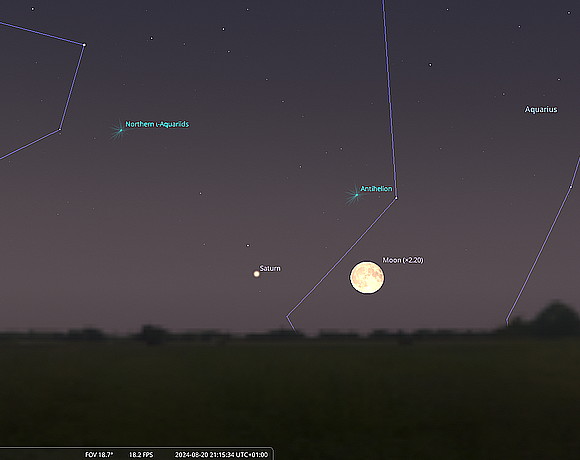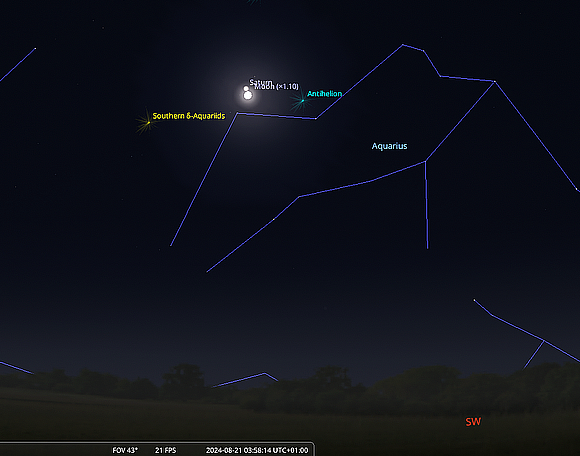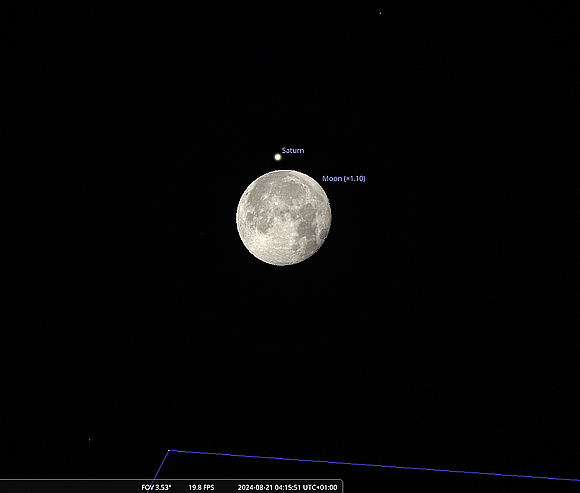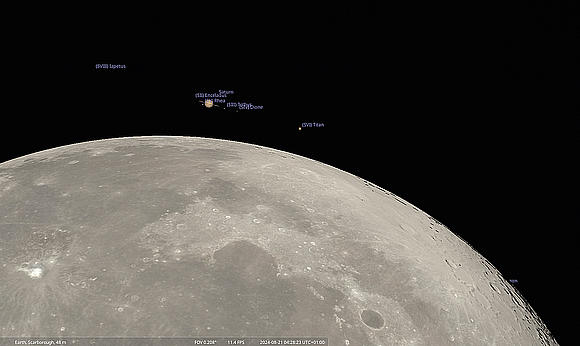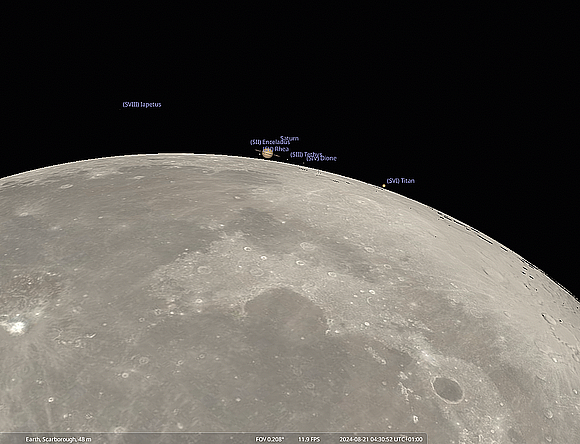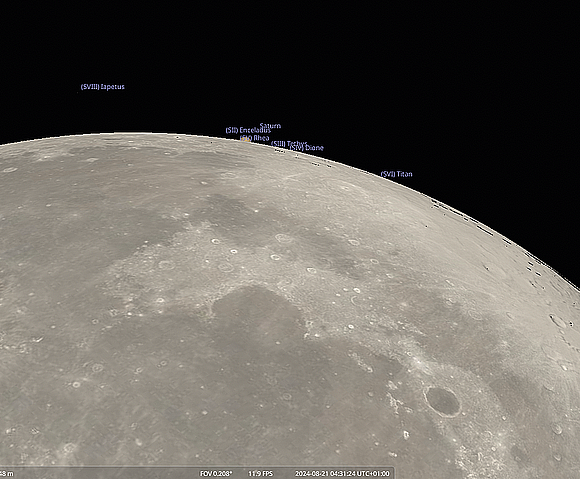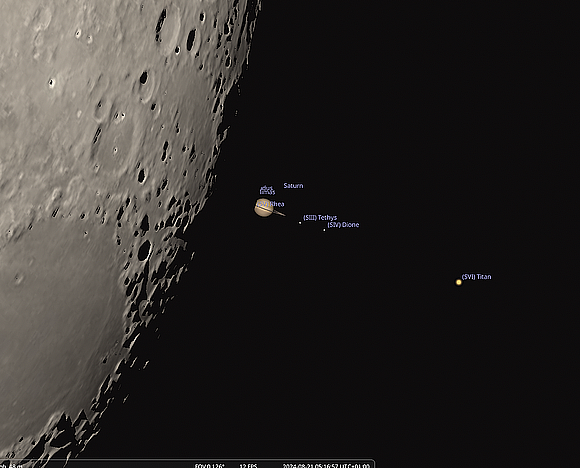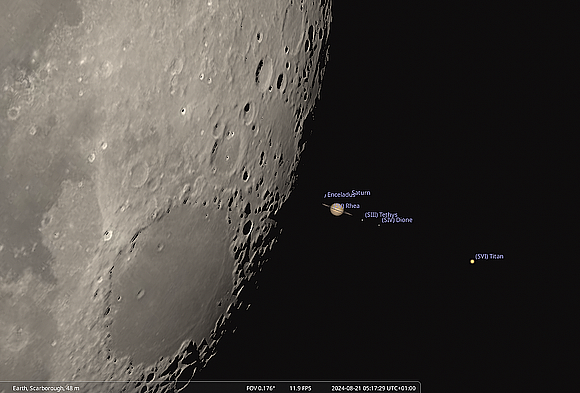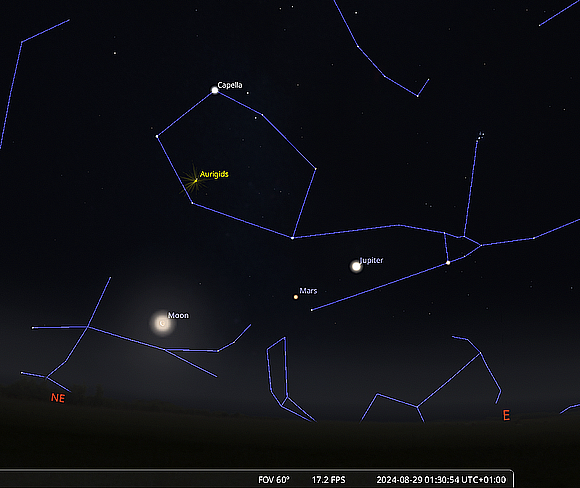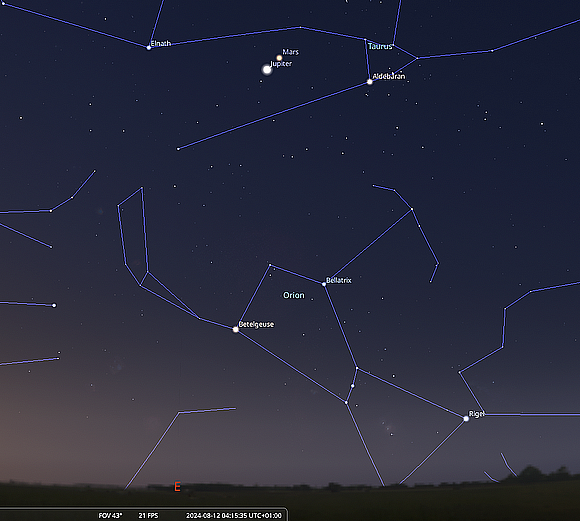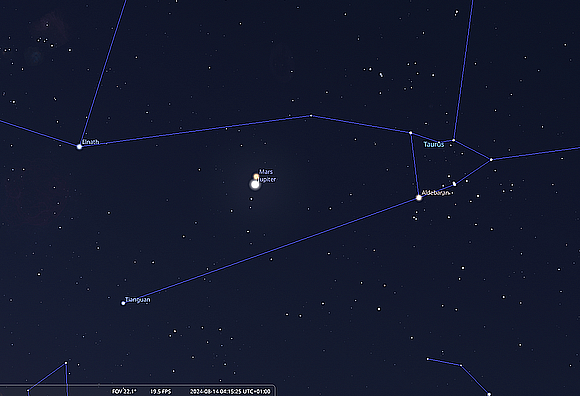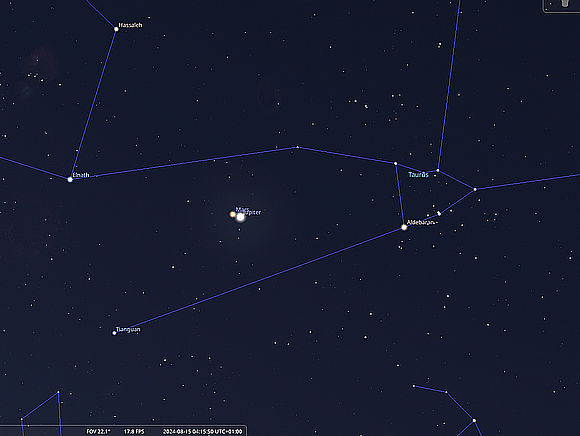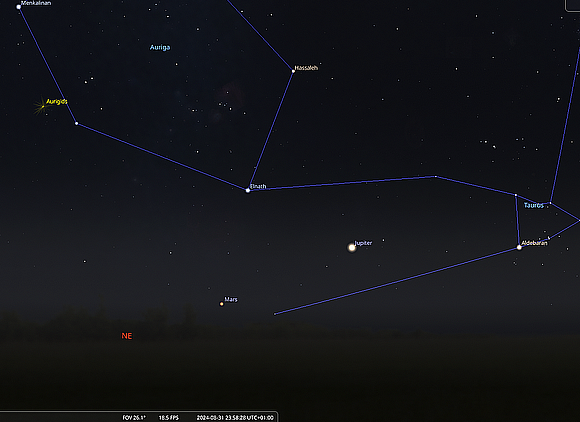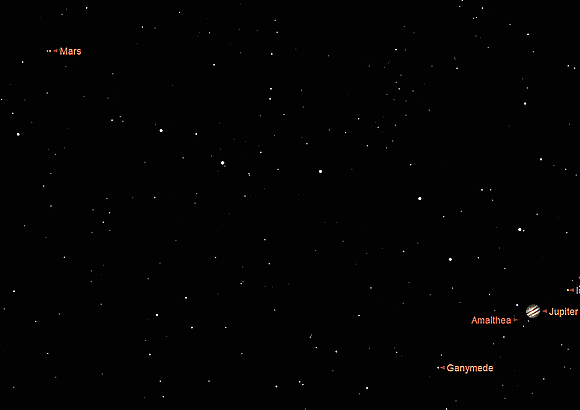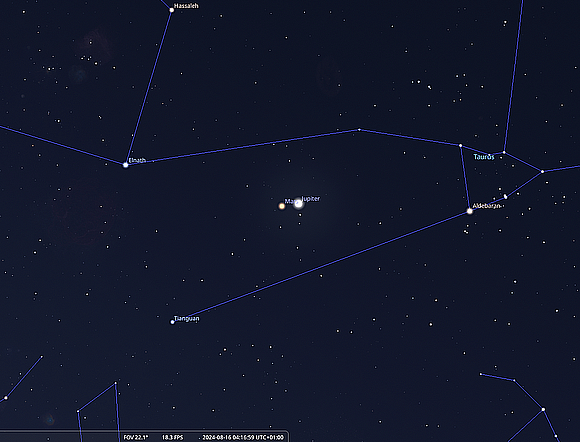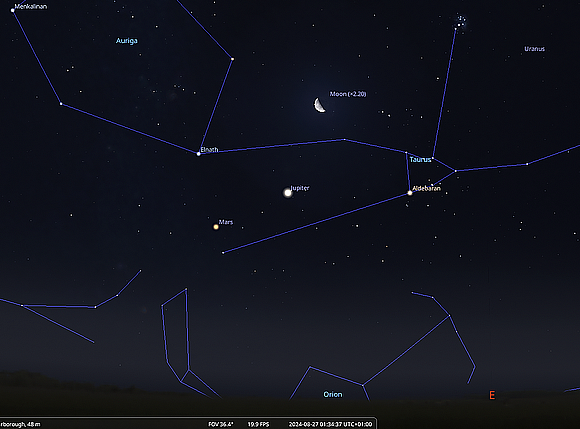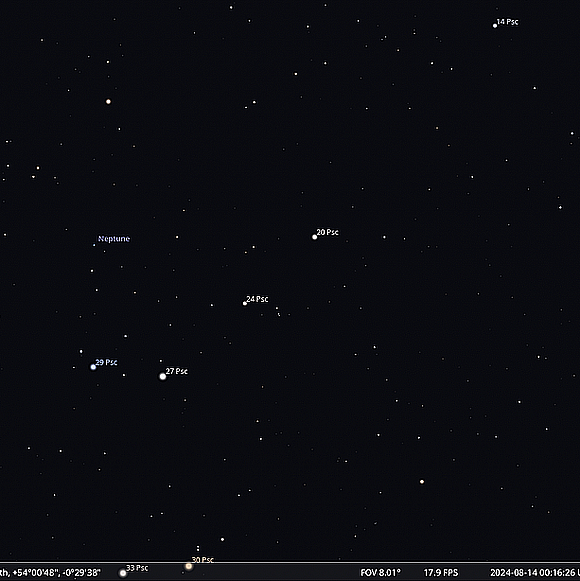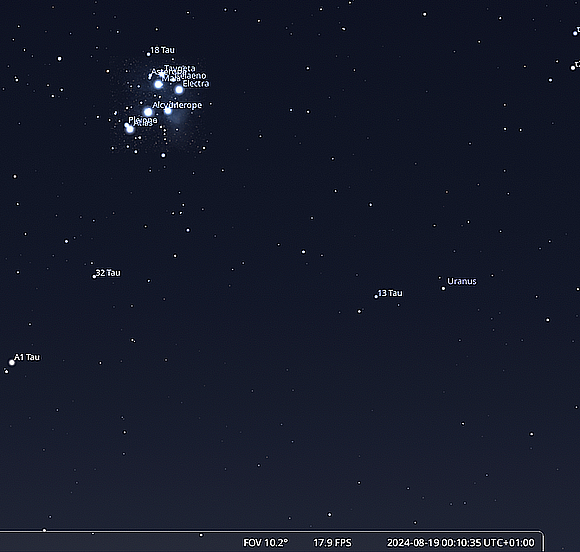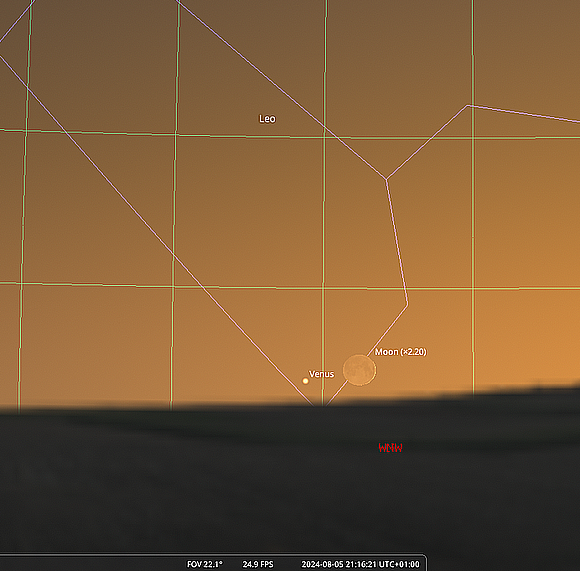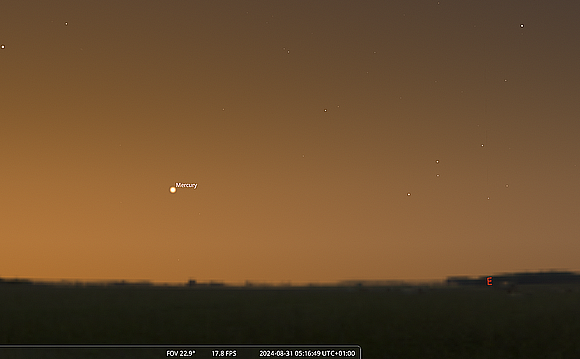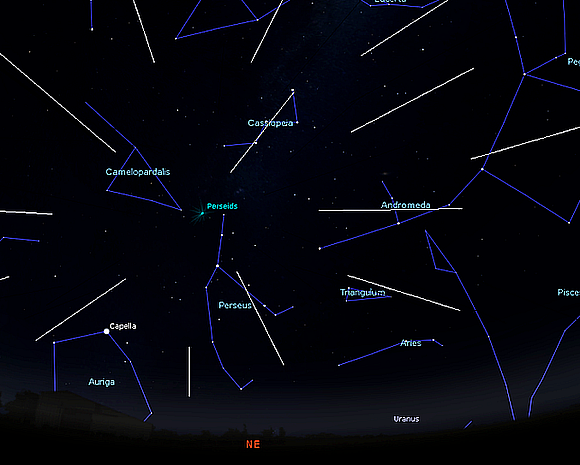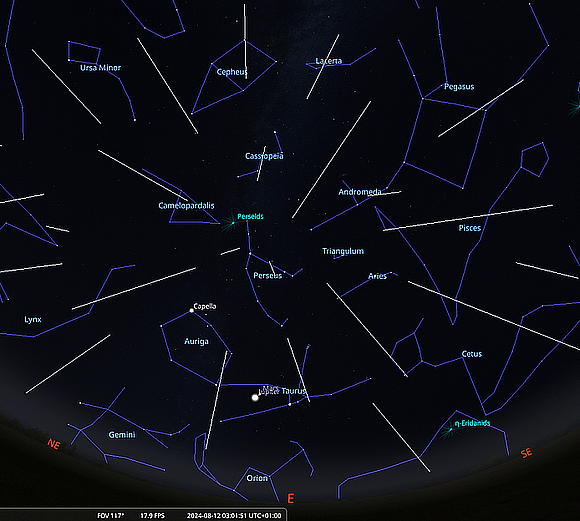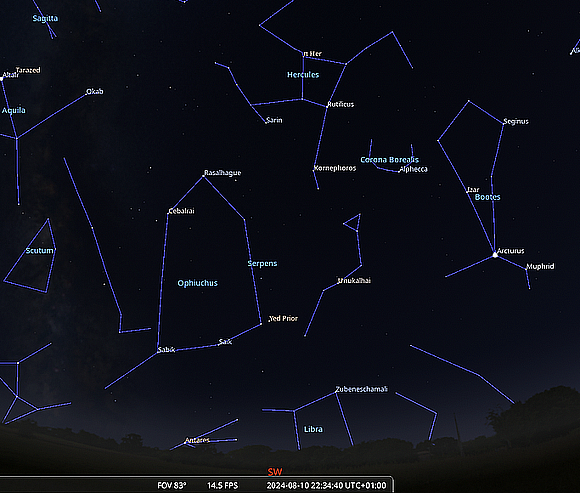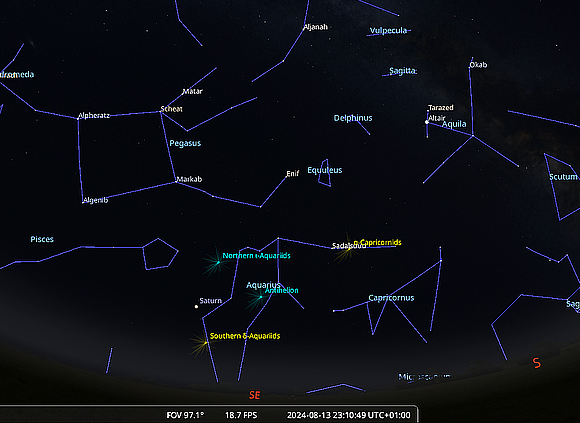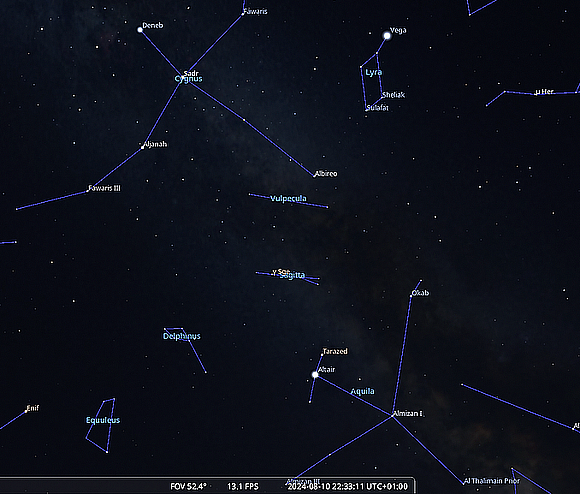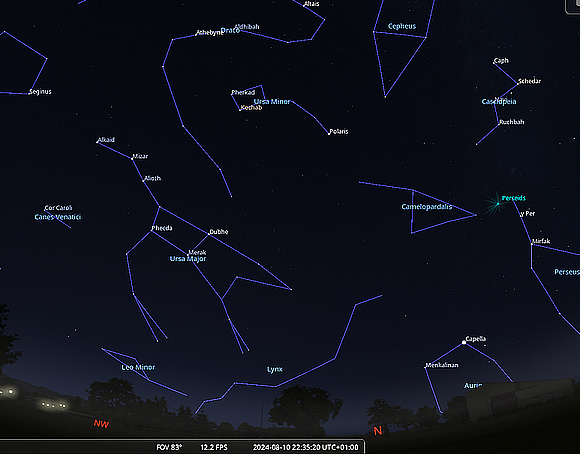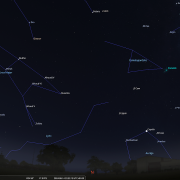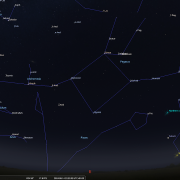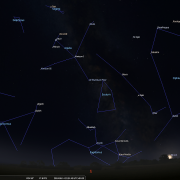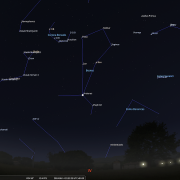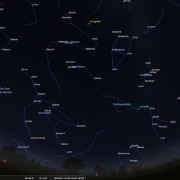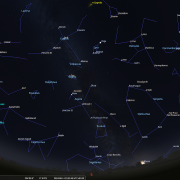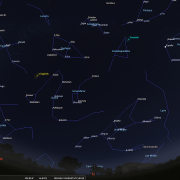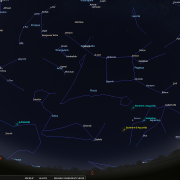In this month's Sky Notes:
- Planetary Skylights.
- August Meteors - Perseids and NCL reports.
- August Night Sky.
- August 2024 Sky Charts.
Planetary Skylights: A Brief Guide to the August Night Sky
After a lull in planetary action with all the planets hiding in the early morning sky, August sees a marked improvement with two stunning planetary highlights to note in the diary and look out for. First up is a spectacular mid-month conjunction of Jupiter and Mars, followed a week later by an early morning lunar occultation of Saturn. Uranus and Neptune can be tracked down with visual aids, and not to be left out Mercury and Venus offer challenging observing opportunities as well. A busy month indeed!
 Saturn is the first of the naked eye planets to rise, doing so shortly after 22:30hrs at the start of August and by 20:30hrs at the end of the month. It will then be a viable observing target, especially for observers able to embrace the midnight hours. Currently at magnitude +0.63 Saturn appears conspicuous amongst the stars of southern Aquarius, a region of the sky devoid of brighter stars. Saturn does not culminate until post-midnight reaching 25 degrees above the south horizon, but still 7 degrees below the celestial equator, not crossing into the northern hemisphere of the sky until 2026.
Saturn is the first of the naked eye planets to rise, doing so shortly after 22:30hrs at the start of August and by 20:30hrs at the end of the month. It will then be a viable observing target, especially for observers able to embrace the midnight hours. Currently at magnitude +0.63 Saturn appears conspicuous amongst the stars of southern Aquarius, a region of the sky devoid of brighter stars. Saturn does not culminate until post-midnight reaching 25 degrees above the south horizon, but still 7 degrees below the celestial equator, not crossing into the northern hemisphere of the sky until 2026.
Through the eyepiece those expecting to view the glorious ring system may be disappointed to note that the orientation is barely 3 degrees, increasing slightly to 5 degrees later this year, before finally closing at ring plane crossing in March 2025 when the rings will be practically edge on. Under good seeing conditions (post-midnight) typical 100mm (4") telescopes will reveal the rings, but little to no structure.
Saturn has over 80 moons, most of which are tiny, but a clutch of 'decent sized' satellites including Rhea, Iapetus, Dione, Tethys, Enceladus and Mimas, should become easier to spot as specks of light as the rings continue to close. Saturn’s largest moon by far, Titan, is apparent in the humblest of instruments as a brighter speck.
Saturn is involved in one of the highlights of the month when on Aug 21st it is occulted by the Moon in the early morning hours. Look for them rising together around 21:15hrs on the evening of the 20th with Saturn 3 degrees left of the Moon. By the early morning hours of the 21st the Moon has slid underneath Saturn, the separation just 6 arc-minutes by 04:15hrs BST.
It's not until 04:30hrs that Saturn (along with Titan) start to sink below the lunar rim taking less than a minute to disappear. Titan re-emerges shortly after 05:00hrs with Saturn following a few minutes later by 05:12hrs from behind the now unlit part of the lunar limb next to Mare Crisium. Skies will then be beginning to lighten as sunrise approaches, but dark enough to observe the event. Fingers crossed for decent conditions, set the alarm: it should be a fascinating watch.
Times stated are for the locale of Whitby - North Yorkshire and will vary further afield. If you are wanting to view Saturn’s ingress and egress from your location, be prepared for time discrepancies, perhaps use a planetarium app for your location, plan ahead and enjoy!
 Mars is slowly gaining the late evening sky, visible just before 01:00hrs at the start of August and before midnight by the end. Look for the red planet in the ENE tracking eastwards below the Pleiades star cluster and through Taurus passing above Aldebaran early in the month. Mars is also gaining in elevation, from 30 degrees at dawn on August 1st, to over 45 degrees by dawn at the months end, increasing in apparent magnitude from +0.9 to +0.73 over the same period.
Mars is slowly gaining the late evening sky, visible just before 01:00hrs at the start of August and before midnight by the end. Look for the red planet in the ENE tracking eastwards below the Pleiades star cluster and through Taurus passing above Aldebaran early in the month. Mars is also gaining in elevation, from 30 degrees at dawn on August 1st, to over 45 degrees by dawn at the months end, increasing in apparent magnitude from +0.9 to +0.73 over the same period.
Through the eyepiece Mars still exhibits a disappointingly small disk barely 7 arc-seconds in diameter and features will be difficult to distinguish using apertures under 330mm (12"). The waning Moon lies above-left of Mars early morning Aug 28th with Jupiter off to the right. The following morning the Moon lies lower left of Mars during the early morning hours.
Mars is involved in one of the planetary highlights of the summer when in very close conjunction with Jupiter. Note how over the first week of August the red planet gradually closes in on Jupiter as it passes through Taurus, and by the 12th the pair are separated by just a few degrees.
Mars continues to close in on Jupiter over the next couple of days and by the 14th is just 25 arc-seconds away. The conjunction is closest on the 15th when the separation has reduced to 21 arc-seconds and both planets will be visible in low power eyepieces in shorter focal length telescopes. The separation has increased to 45 arc-seconds the following day.
Mars continues to pull away from Jupiter, already 8 degrees by the end of the month as Mars moves out of Taurus. Both Mars and Jupiter have then become very late evening objects rising just before midnight.
 Jupiter currently resides in the heart of the Taurus and like Mars rises in the early morning hours at the start of August and just before midnight by the month's end. Jupiter is far more conspicuous than Mars reaching mag -2.3 this month catching the eye of anyone up post midnight. Through the eyepiece Jupiter is always a fine sight, noticeably oblate and a whopping 36 arc- seconds in diameter offering up detail and phenomena accessible to very modest instruments.
Jupiter currently resides in the heart of the Taurus and like Mars rises in the early morning hours at the start of August and just before midnight by the month's end. Jupiter is far more conspicuous than Mars reaching mag -2.3 this month catching the eye of anyone up post midnight. Through the eyepiece Jupiter is always a fine sight, noticeably oblate and a whopping 36 arc- seconds in diameter offering up detail and phenomena accessible to very modest instruments.
Particularly noticeable is the darker atmospheric banding across the disc and attendant Galilean moons in close proximity. When turned in Earth's direction the great red spot (GRS) is observable in instruments of 114mm (4 1/2") apertures and above. Jupiter’s major 'storm' is currently not the feature it was 30 years ago, having reduced in size by almost 40% in that period. The daily dance of the four Galilean Moons is fascinating to watch, an ever changing 'mini solar system', throwing up a different configuration each night.
It is, however, the extremely close conjunction with Mars that will garner attention this month. Blessed with decent sky conditions, observers will note how Mars closes in on Jupiter over the first 12 days of August, until the two appear very close to the naked eye. The pair are closest on the 15th and given some clear skies (or at least sufficiently clear to view the conjunction) it should be a spectacular meeting. One thing to reflect upon should you manage to observe any of the conjunction at closer quarters is the difference in disk size, that of Jupiter. many times larger than that of Mars - even though it is over 750 million Km distant as opposed to Mars' 210 million Km.
Low power eyepiece view of Jupiter-Mars conjuction - Aug 15th @ 01:30hrs.
View will be upside down in reflecting telescopes. (Click for larger image)
The waning Moon lies closest to Jupiter on Aug 27th, several degrees above and right.

 Uranus and Neptune will both be visible before midnight by the month's end but can be tracked down in the early morning hours throughout August. Neptune rises first residing some 11 degrees left of Saturn, below the faint loop of stars marking the western fish of Pisces. Neptune itself lies within a sort of faint loop of 5th and 6th magnitude stars, the nearest being 29 psc 1.5 degree below. At almost 8th magnitude Neptune will require at least a 130mm (5") aperture to positively identify the tiny 2.5 arc-second disc through the eyepiece.
Uranus and Neptune will both be visible before midnight by the month's end but can be tracked down in the early morning hours throughout August. Neptune rises first residing some 11 degrees left of Saturn, below the faint loop of stars marking the western fish of Pisces. Neptune itself lies within a sort of faint loop of 5th and 6th magnitude stars, the nearest being 29 psc 1.5 degree below. At almost 8th magnitude Neptune will require at least a 130mm (5") aperture to positively identify the tiny 2.5 arc-second disc through the eyepiece.
Uranus lies 5 degrees lower right of the Pleiades star cluster and is technically visible to the naked eye at mag +5.8, though only from very dark transparent locations. An aperture of 75-80mm (3") is needed to spot the tiny 3.5-degree grey/green disk.
 Up for a challenge! See if you can spot Venus which makes an extremely brief appearance just above the WNW horizon in the early August evening sky. As part of this challenge, spot a 2% illuminated new Moon just to the right! To do this specifically from the Whitby area view on Aug 5th just above the WNW horizon between 21:05 and 21:20hrs BST. A very flat, unobstructed horizon is required, but given a clear sky (a bigger ask) it is just about possible and one to be proud of! The following evening the 4% crescent moon lies 9 degrees to the left of Venus, a second and final chance of spotting both.
Up for a challenge! See if you can spot Venus which makes an extremely brief appearance just above the WNW horizon in the early August evening sky. As part of this challenge, spot a 2% illuminated new Moon just to the right! To do this specifically from the Whitby area view on Aug 5th just above the WNW horizon between 21:05 and 21:20hrs BST. A very flat, unobstructed horizon is required, but given a clear sky (a bigger ask) it is just about possible and one to be proud of! The following evening the 4% crescent moon lies 9 degrees to the left of Venus, a second and final chance of spotting both.
 Finally, Mercury commences a morning apparition late in August and may be glimpsed in the dawn sky a few degrees above the east horizon. You will need to view around 05:00-05:20hrs having a flat horizon. At mag +0.8 Mercury should be visible to the naked eye, but perhaps sweep above the east horizon by a few degrees with binoculars to help. As the apparition moves into September Mercury will grow brighter still and gain a little in elevation.
Finally, Mercury commences a morning apparition late in August and may be glimpsed in the dawn sky a few degrees above the east horizon. You will need to view around 05:00-05:20hrs having a flat horizon. At mag +0.8 Mercury should be visible to the naked eye, but perhaps sweep above the east horizon by a few degrees with binoculars to help. As the apparition moves into September Mercury will grow brighter still and gain a little in elevation.
August Meteors - The Perseids
Meteor activity is rather low during summer, with one, glorious exception; the Perseids, one of the more prolific meteor showers and without doubt the most widely observed by the public. The Perseids are active from late July until after mid-August, with activity highest from Aug 8th-15th. The shower normally reaches a peak overnight of Aug 11-12th. Sometimes known as "The tears of St. Lawrence"; the martyred Christian deacon whose feast day falls on Aug 10th, just before the Perseids peak, these particular ‘tears’, like most meteor showers, are composed of debris deposited over many thousands of years by periodic comets.
Perseids are associated with the periodic comet Swift Tuttle which has an orbital period of around 133 years. It appeared last in 1992 when enhanced rates were seen, the next pass being in 2126 when the comet could be as bright as Comet Hale-Bopp was, providing that predictions are correct of course! Alas, few reading this in 2024 will see it! It is widely perceived amongst the public that meteors are quite substantial in size, but this is not so, Perseid meteoroids are not dissimilar in size and density to that of instant coffee granules with the occasional pea or marble sized fragment. Each August, Earth encounters various strands of the Swift-Tuttle debris stream giving rise to the eagerly anticipated shooting stars.
Penetrating the upper atmosphere some 60 (100km) miles up, Perseid 'meteoroids' reach speeds of 43miles/second, interacting with atoms as they push through the air, a process known as ablation, before becoming ionised and releasing a packet of light. It is this brief luminous flash we call a meteor. Particularly bright examples often leave behind persistent ionisation trails in their wake, the classic shooting star.
The radiant of the shower: the location in the sky from which the meteors appear to emanate, lies within the constellation of Perseus, which in August is rising in the northeast during the evening and is best placed around 07:00hrs. For 2024 the actual shower peak falls during the afternoon of Aug 12th, this means the probable optimum time will be the early morning hours of Aug 12th (Monday). Under ideal conditions the zenith hourly rate (ZHR) for the Perseids is typically 80-120, but actual observed rates by one person will be around 40% of this.
Observers up before dawn (say around 03:00) would expect to see perhaps 30 - 50 meteors per hour. Late evening (post 22:00hrs) of Aug 11th will likely yield around 10 -15 per hour. A 50% illuminated Moon will hamper observation until it sets around midnight, after this, conditions are ideal - weather aside. Do not just observe on this date only - the night of 12/13th could be just as productive and at worst a 50% reduction in numbers would be expected. Try to observe in areas of the sky a good hand span away from Perseus and between 40-70 degrees above the horizon. Fingers crossed, wrap up warm and flask of tea, coffee, whisky at hand and enjoy one of nature’s great free spectacles.
Noctilucent Cloud/Aurora Watch
There has been little activity recently for both phenomena, certainly noctilucent cloud sightings have been minimal in the last few weeks and it is nearing the end of the season for this type of cloud. Aurora activity has also been subdued with any increased levels seeming to occur in daylight hours. Unlike noctilucent cloud, the 'aurora season' is certainly not over so keep tabs on aurora web sites.
August Night Sky 2024
August sees the resumption of true astronomical twilight, the deepest level of twilight not attained since May, which by the back end of the month will be perceptively lengthening in duration. Many amateur astronomers will then be dusting off their telescopes in preparation for serious dark sky observations. Before then early August still suffers from light nights and it's still 22:00hrs before the brightest stars emerge. Arcturus in the west and Vega overhead are first to do so, followed by Deneb (high to the east), Altair (midway up in the south) and completing this initial clutch of stellar luminaries, Capella low to the north. Antares may just be glimpsed low to SW if the observer’s horizon is flat and seeing good.
By 22:30hrs many of the fainter stars visible to the naked eye complete the celestial jigsaw puzzle, making constellation recognition that much easier. You can then locate the familiar saucepan outline of the ‘Plough’ (part of Ursa Major, the Great Bear) high in the NW, the arc of its handle pointing down in the direction of conspicuous Arcturus in Boötes the Herdsman. Note the delicate starry circlet of Corona Borealis - the Northern Crown, its chief star Alphecca, the centre stone of this celestial tiara situated upper left of Arcturus.
Much of the SW aspect is occupied by just two constellations, the sprawling figure of Hercules occupies the region higher in the SW and is best identified by the ‘keystone’ asterism. Below Hercules extending down toward the WSW horizon, the huge and rather indistinct constellation of Ophiuchus, the serpent bearer stands. As dusk falls in this direction you may spy the orange hue of Antares in Scorpius just above the SW horizon. Due south, standing on the horizon is the large asterism known as the ‘Teapot’, the visible portion of Sagittarius from the UK. It may be traced if skies are transparent. Located in this direction, on the border between these two constellations amidst the celebrated star clouds of the Milky Way, lies the centre of our galaxy 27,000 light years away.
Yet more zodiac constellations fill the SE and E horizons, the ecliptic being low to the horizon at this time of year. These include Capricornus - the Sea Goat (SSE), Aquarius - the Water Bearer (ESE) and Pisces - the Fish (E). None are particularly easy to trace from light polluted skies, or when strong moonlight present. Choose a dark location to view these groups satisfactory. Note that later in the month Saturn highlights the southern reaches of Aquarius, below the zig-zag asterism of the water jar.
Rivalling Arcturus in brilliance, steely blue Vega in the small lozenge shaped pattern of Lyra rides high overhead. Along with Deneb and Altair, it makes up the ‘summer triangle’. Look for the two small but distinctive patterns of Sagitta and Delphinus adjacent to the Deneb/Altair side of the triangle. Sagitta is comprised of just 5 stars and according to one legend is associated with Cupid’s arrow. The close-knit group of Delphinus does (with a little imagination) resemble the outline of a dolphin leaping out of water. Bizarrely the group is also known as ‘Jobs coffin’.
Facing North, look for the pole star Polaris, in Ursa Minor, located by using the pointer stars in the ‘bowl’ of the Plough. The zenith is occupied by the head of Draco, the body of which winds between the two bears. Climbing away from the NNE horizon the great hero Perseus strikes a pose, whilst the familiar “W” pattern of Queen Cassiopeia holds court above his right shoulder, and above sits her husband, King Cepheus. Her daughter, the princess Andromeda is located lower right, marked by a chain of stars extending towards the winged horse Pegasus which occupies the mid-regions of the east sky. It is within the borders of Andromeda that our “sister” galaxy can be glimpsed on clear moonless nights, the most remote object visible to the naked eye - a staggering 2.65 million light years away!
Below Andromeda sit two small constellations - Triangulum, in which M33 - the other pinwheel galaxy, one of the 'big three' galaxies in the local group along with the Andromeda galaxy and our Milky Way. Below Triangulum lie the crooked line of stars marking Aries. Not far to the east, charging over the horizon is Taurus, the exquisite open cluster of the Pleiades marking the bull's tail, the sight of which reminds astronomers that a change of season is in the offing, autumn lies in readiness!
August Sky Charts
Additional Image Credits:
- Planets and Comets where not otherwise mentioned: NASA
- Sky Charts: Stellarium Software and Starry Night Pro Plus 8
- Log in to post comments

